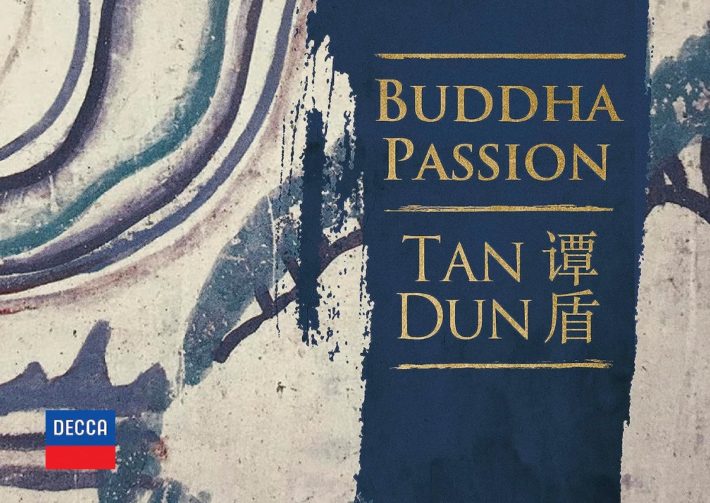Tan Dun’s ‘Buddha Passion’ began with a visit to ancient caves in the Dunhuang desert, which have hundreds of drawings and paintings featuring musicians, instruments, and orchestras. Dun was “so deeply moved that I could almost hear the sounds emanating from the murals.” He then spent the next six years composing a work that would give the murals voice, completing it in 2018. The music is a wide-ranging mix of styles, including opera (both Western and Chinese), Western classical music, and the Asian folk tradition. The required forces include four soloists, two choirs, two Indigenous singers and symphony orchestra with a large battery of percussion.
Dun’s libretto, which he assembled himself, asks the four soloists (and choirs) to portray several characters throughout the work. Although Dun has chosen to call it a ‘Passion,’ implying a similarity to Bach’s two masterworks, its six acts seem closer to the oratorio tradition. There is no narrator, for example, and I would have struggled to understand the work’s structure and flow without the additional explanations found in the liner notes. (In Bach’s Passions, the Evangelist obviously serves this function.
Each act tells a story, ending with an ‘Ode’ that summarizes the moral lesson we are meant to take away. Soloists and choirs sing Buddhist texts in a mix of Chinese, Sanskrit and English. In this way, the listener joins a little prince on his journey as he moves through each scene, as he eventually finds enlightenment and becomes Buddha, and finally reaches Nirvana. (It is surely this aspect of theological growth and understanding that Dun sees as the connection with Bach’s Passions.)
Related Posts
- Review: “Butterfly Lovers” – Joshua Bell, Violin
- Review: Bach – Matthäus Passion – Pichon (2022)
- Review: Puccini – Madama Butterfly – Foster
Dun is an excellent conductor of his own music and gets impressive results from his forces. The singers of the International Choral Akademie perform the various languages masterfully, though diction could be crisper. They also embrace the music’s varying singing styles, whether Western (the coda of the final ode in Acts III and VI are powerfully cinematic) or Eastern (the embellished melodic cells and onomatopoetic writing in the opening of Act IV, or the overtone singing in section that follows) brilliantly.
Soloists are uniformly impressive. If bass-baritone Shenyang stands out, it is perhaps because of his overtone singing, and how fully he characterizes his various characters, which include a king, an emperor, and Buddha. In the second act, soprano Sen Guo, and tenor Chuanyue Wang are enthusiastic and impassioned in their Puccini-esque duet. Yining Chen’s singing (and Pipa playing) is another highlight – I believe in live performance she also dances; an element unfortunately denied us here.
I found the fifth act particularly entrancing. The story of a monk who gives his last drop of water to save a dying woman, only for her to die in his arms after a chilly night spent huddled together, is deeply touching, especially as performed here by Batubagen and Weiwei Tan, the two Indigenous musicians. The opening of the story is sung using Mongolian throat singing, accompanied by a Xiqin (a Chinese/Mongolian string-instrument). Ms. Tan’s singing is stunning: her opening moments have a poignant fragility that grows into the soaring lyricism of ‘Love is Destined to Part’ (Act 5/Part 4).
Recorded live in the Shanghai Oriental Art Center Concert Hall on June 20, 2019, the audience is virtually silent. The engineered sound embraces a deep and wide soundstage, the balance between orchestra, soloists, and choir exceptionally fine, though having the choir mixed more forwardly would improve diction clarity.
Dun, who embraces a diversity of styles in his writing, can divide opinions. You can find articles about the work in which some writers argue this diversity is individual and that the various musics flow together organically, and others who argue the opposite. Some appreciate its cinematic moments (Dun won an Academy Award in 2000 for his ‘Crouching Tiger, Hidden Dragon’ score), while others cite this as a weakness. These arguments seem somewhat pedantic, and all too often shift focus away from the music’s primary purpose. Did this work move me? Did it take me on an emotional and intellectual journey? Did it ask me to explore, and perhaps challenge, my own emotions and thoughts? To all of these I answer yes, and that is an excellent description of what good music does.

Tan Dun – Buddha Passion
Orchestre National de Lyon
International Choir Academy Lübeck
Tan Dun – Conductor
Decca, CD 4854221
Related Albums
Crouching Tiger, Hidden Dragon | Water Concerto | Fire Ritual | Ghost Opera
Read more classical music reviews or visit The Classic Review Amazon store
Follow Us and Comment:
Get our periodic classical music newsletter with our recent reviews, news and beginners guides.
We respect your privacy.








